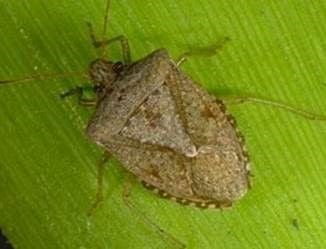Well, as cooler weather approaches, so does the annual invasion of insects into our homes. I have been asked recently about stink bugs in particular. While there are dozens of types of stink bugs in Kentucky, the Brown Marmorated Stink Bug is most likely the one causing the most trouble. This insect is a native of Asia and showed up in the United States in the late 1990s.
Most stink bugs feed on plants, although a few are predators of other insects. So will this insect bite a human? Some species of stink bug can bite, although it is extremely rare and it is not something they plan on doing. But don’t worry, they will not attack.
Stink bugs produce a bad smell when they are threatened or crushed. That is their way to protect themselves from predators. The smell is also used to attract other stink bugs. Some people compare the smell to the herb cilantro. Many other insects, like ants or ladybugs, also have an odd smell when disturbed or crushed.
So why is there a sudden immigration of not only stink bugs but other insects into your home? Well, alot of insects and other animals are starting to try to find a place to spend the winter. In nature, many insects spend the winter hiding under stones, in ground cover, or in weeds. To them, your house looks like a big rocky outcrop. They will start by congregating on the outside of your home and if they find a crack or hole, they will enter. Usually they will just stay inside the walls or in quiet places like an attic or a crawl space, although they will occasionally enter our living areas.
The best defense is prevention. You should start by inspecting the outside of the building carefully. Cracks or gaps around windows or doors can allow insects inside. If you have a gap under your door, install a sweep for a tighter fit. Any cracks should be sealed with caulk. Also check where pipes or cables enter the home to make sure there are no points of entry there. It does not take a very big space for an insect to come in. In fact, a gap of 1/16 inch or less will permit entry of insects and spiders; 1/4 inch-wide gaps (the diameter of a pencil) are large enough for entry of mice; 1/2 inch gaps are adequate for rats.
Once the insects are inside, they can be vacuumed up. Just be sure to empty it after use. But a word of warning, this may make your vacuum smell like a stink bug.
If you feel like a chemical control is warranted, I do not recommend spraying anything inside the home. There are several insecticides labeled to be used around the home. For more information on these chemicals call me (Amanda Sears at 859-623-4072; amanda.sears@uky.edu) or check out this website:
http://www2.ca.uky.edu/entomology/entfacts/ef641.asp
Educational programs of the Cooperative Extension Service serve all people regardless of race, color, sex, religion, disability or national origin.



















Commented
Sorry, there are no recent results for popular commented articles.